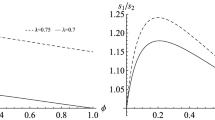Abstract
This paper proposes a multi-region growth model with endogenous labor supply, endogenous amenity, and capital accumulation. Although the production side is the same as in the neoclassical growth theory, in order to solve issues related to regional migration with capital accumulation we propose an alternative approach to consumer decisions about time distribution between work and leisure, housing consumption and saving. We show that the dynamics of the J-region national economy can be described by J-dimensional differential equations. We simulate the long-term economic structure of the national economy with three regions. It is demonstrated that with the Cobb–Douglas production functions and specified values of the parameters, the national dynamics has a unique equilibrium. We also carry out comparative statics analysis with regard to productivity levels, amenity parameters, propensity to save, and the population.
Similar content being viewed by others
References
Andersson AE, Johansson B, Anderson WP (eds) (2003) The economics of disappearing distance. Ashgate, Hampshire
Ayong Le Kama AD (2001) Sustainable growth, renewable resources and pollution. J Econ Dyn Contr 25:1911–1918
Benhabib J, Perli R (1994) Uniqueness and indeterminacy: on the dynamics of endogenous growth. J Econ Theory 63:113–142
Blomquist GC, Berger MC, Hoehn JC (1988) New estimates of quality of life in urban areas. Am Econ Rev 78:89–107
Brecher RA, Chen ZQ, Choudhri EU (2002) Absolute and comparative advantage, reconsidered: the pattern of international trade with optimal saving. Rev Int Econ 10:645–656
Burmeister E, Dobell, AR (1970) Mathematical theories of economic growth. Collier Macmillan, London
Campbell JY, Ludvigson S (2001) Elasticities of substitution in real business cycle model with home production. J Money Credit Bank 33:847–875
Combes PG, Duraton G, Gobillon L (2004) Spatial wage disparities: Sorting matters! CEPR Discussion Paper, 4220, Paris
Cropper ML (1976) Regulating activities with catastrophic environmental effects. J Environ Econ Manage 3:1–15
Deardorff AV (1973) The gains from trade in and out of steady state growth. Oxford Econ Pap 25:173–191
Diamond DB, Tolley GS (eds) (1981) The economics of urban amenities. Academic, New York
Duranton G, Monastiriotis V (2002) Mind the gaps: the evolution of regional earnings inequalities in the UK 1982–1997. J Reg Sci 42:219–256
Eaton J (1987) A dynamic specific-factors model of international trade. Rev Econ Stud 54:325–338
Findlay R (1984) Growth and development in trade models. In Jones RW, Kenen RB (eds) Handbook of international economics. North-Holland, Amsterdam
Forster BA (1973) Optimal consumption planning in a polluted environment. Econ Rec 49:534–545
Frederick S, Loewenstein G, O’Donoghue T (2002) Time discontinuing and time preference: a critical review. J Econ Liter 40:351–401
Fujita M (1989) Urban economic theory: land use and city size. Cambridge University Press, Cambridge
Glaeser EL, Maré DC (2001) Cities and skills. J Labor Econ 19:316–342
Greenwood J, Hercowitz Z (1991) The allocation of capital and time over the business cycle. Journal of Political Economy 99: 1188–1214
Gruver GW (1976) Optimal investment in pollution control capital in a neoclassical growth context. J Environ Econ Manage 3:165–177
Ikeda S, Ono Y (1992) Macroeconomic dynamics in a multi-country economy: a dynamic optimization approach. Int Econ Rev 33:629–644
Jones LE, Manuelli RE (1995) Growth and the effects of inflation. J Econ Dyn Contr 19:1405–1428
Kanemoto Y (1980) Theories of urban externalities. North-Holland, Amsterdam
Kennedy PW (1994) Equilibrium pollution taxes in open economies with imperfect competition. J Environ Econ Manage 27:49–63
Ladrón-de-Guevara A, Ortigueira S, Santos MS (1999) A two sector model of endogenous growth with leisure. Rev Econ Stud 66:609–631
Mäler KG (2000) Development, ecological resources and their management: a study of complex dynamic systems. Eur Econ Rev 44:645–665
Oniki H, Uzawa H (1965) Patterns of trade and investment in a dynamic model of international trade. Rev Econ Stud 32:15–38
Plouder GC (1972) A model of waste accumulation and disposal. Can J Econ 5:119–125
Roy JR, Johansson B (1993) A model of trade flows in differentiated goods. Ann Reg Sci 27:95–115
Ruffin RJ (1979) Growth and the long-run theory of international capital movements. Am Econ Rev 69:832–842
Rupert P, Rogerson R, Wright R (1995) Estimating substitution elasticities in household production models. Econ Theory 6: 179–193
Sorger G (2002) On the multi-region version of the Solow-Swan model. Jpn Econ Rev 54:146–164
Takayama T, Judge GG (1971) Spatial and temporal price and allocation models. North-Holland, Amsterdam
Turnovsky SJ (1999) Fiscal policy and growth in a small open economy with elastic labor supply. Can J Econ 32:1191–1214
Wirl F (2004) Sustainable growth, renewable resources and pollution: thresholds and cycles. J Econ Dyn Contr 28:1149–1157
Zhang WB (1993) Woman’s labor participation and economic growth: creativity, knowledge utilization and family preference. Econ Lett 42:105–110
Zhang WB (2003) A theory of interregional dynamics: spatial models with capital, knowledge, and structures. Springer, Berlin
Zhang WB (2005) Economic growth theory. Ashgate, Hampshire
Zhang WB (2006) Economic growth with income and wealth distribution. Palgrave Macmillan, New York




